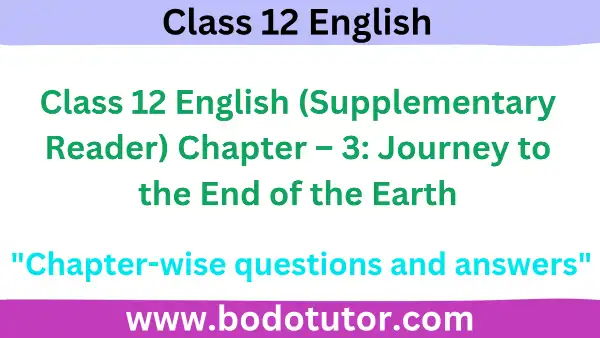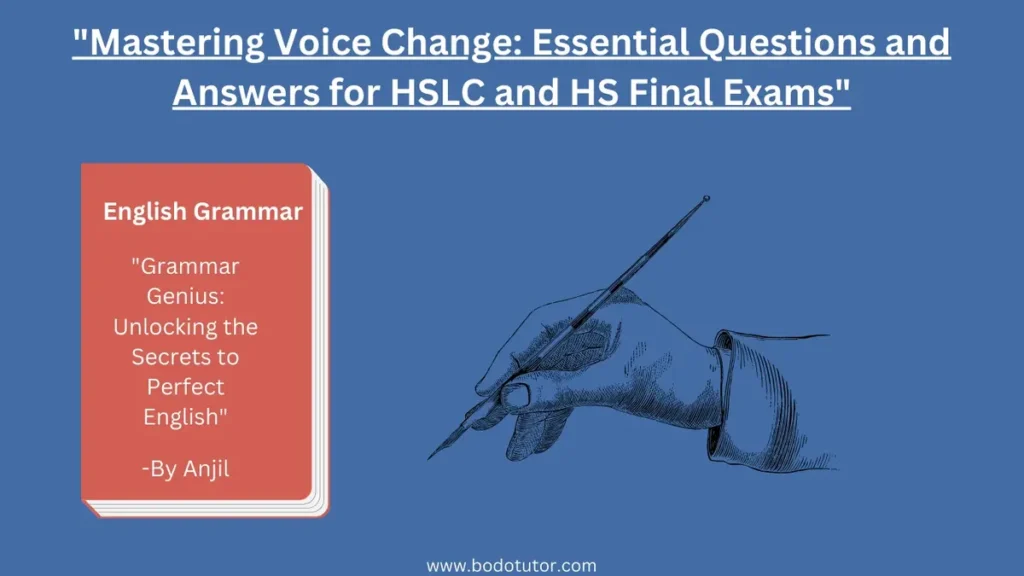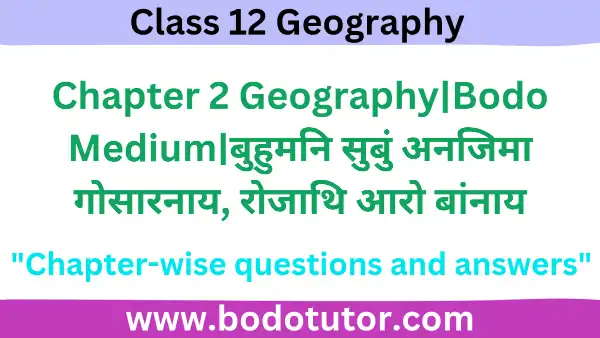Class 12 English (Supplementary Reader) Chapter – 3: Journey to the End of the Earth: Welcome to bodotutor.com ! Here you will get complete Class 12 English notes based on the AHSEC|ASSEB syllabus. We are starting with Class 12 Chapter 3 Journey to the End of the Earth, and we’ll continue to provide clear, easy-to-understand notes for every chapter to help you in your exams. Stay connected for regular updates and more study materials!

Class 12 English (Supplementary Reader) Chapter – 3: Journey to the End of the Earth
Answer the Following Questions:
1. Where did Tishani Doshi’s journey to Antarctica begin?
Ans: Her journey began from Madras, India (13.09° north of the Equator).
2. Which vessel did she board for her journey?
Ans: The Russian research vessel Akademik Shokalskiy.
3. What is Gondwana?
Ans: Gondwana was a supercontinent that existed 650 million years ago, including India and Antarctica.
4. How long did it take her to reach Antarctica?
Ans: Over 100 hours by car, plane, and ship.
5. Who is Geoff Green?
Ans: He is the founder of the “Students on Ice” programme.
6. What is the aim of the “Students on Ice” programme?
Ans: To educate high school students about the environment and global sustainability.
7. What role does phytoplankton play in the ecosystem?
Ans: They are microscopic plants that form the base of the ocean food chain and help in carbon fixation through photosynthesis.
8. What did the author experience when she walked on the ocean?
Ans: She walked on a metre-thick ice sheet floating over 180 meters of ocean water – a surreal, connecting experience.
9. Why is Antarctica considered a pristine environment?
Ans: Because it has never sustained a permanent human population.
10. What did the author realise by the end of her journey?
Ans: That everything in nature is interconnected, and small changes can have huge impacts.
Fill in the Blanks:
1. The Russian research vessel was named __________.
Ans: Akademik Shokalskiy.
2. Antarctica contains __________ percent of the Earth’s ice.
Ans: 90.
3. The supercontinent that included India and Antarctica was called __________.
Ans: Gondwana.
4. Phytoplankton carry out __________ using sunlight and carbon.
Ans: Photosynthesis.
5. Geoff Green earlier worked with __________ and retired celebrities.
Ans: Tourists/Curiosity-seekers.
True/False:
1. Antarctica has a diverse and complex ecosystem.
Ans: False.
2. Human civilisation has existed for over a million years.
Ans: False.
3. Geoff Green wanted to educate youth through the Students on Ice programme.
Ans: True.
4. The author walked on the ocean at the Arctic Circle.
Ans: False.
5. Antarctica is a key element in the climate change debate.
Ans: True.
Long Type Questions and Answers:
1. Why did Tishani Doshi travel to Antarctica?
Ans: She traveled as part of the “Students on Ice” programme to understand the environment, study the Earth’s past, and see the effects of climate change firsthand. The journey was a combination of curiosity, environmental education, and adventure.
2. Describe the significance of Gondwana in the chapter.
Ans: Gondwana was a supercontinent that once included Antarctica and India. Understanding this ancient landmass helps us see the evolution of the planet, the movement of continents, and the geological processes that have shaped modern Earth.
3. How is Antarctica important in understanding climate change?
Ans: Antarctica stores half-million-year-old carbon records in its ice cores. Studying it can reveal data about past atmospheric conditions, helping us predict and understand climate trends and global warming.
4. What is the impact of human activity on nature, according to the author?
Ans: In just 12,000 years, humans have caused significant environmental disruption—burning fossil fuels, overpopulation, deforestation, and pollution, which contribute to global warming and ecological imbalance.
5. What is the role of the Students on Ice programme?
Ans: It provides young students with a life-changing educational experience in Antarctica, fostering awareness, responsibility, and motivation to protect the environment through real-world exposure.
6. What was the author’s experience walking on the ocean?
Ans: The author walked on a solid sheet of ice above 180 metres of water. Surrounded by vast whiteness and silence, it was an epiphany about the planet’s fragility and interconnected systems.
7. How does phytoplankton serve as a metaphor in the story?
Ans: Phytoplankton symbolize how small things support the entire ecological balance. Their decline due to climate change could disrupt the entire food chain, showing how minor changes can lead to major consequences.
8. What does the chapter teach about ecological balance and the future of Earth?
Ans: It emphasizes that even minor shifts in delicate ecosystems like Antarctica can lead to global effects. Preserving such areas is crucial for the future, and educating the youth is key to ensuring sustainable practices.
9. Comment on the significance of the title “Journey to the End of the Earth.”
Ans: The title metaphorically and literally refers to the author’s journey to Antarctica—the southernmost point of the Earth. It highlights not only the physical expedition but also an intellectual and emotional exploration into the planet’s past, present, and future, emphasizing humanity’s impact on Earth.
10. How does Antarctica serve as a lens to view the past, present, and future of Earth?
Ans: Antarctica remains untouched by humans, preserving ancient environmental data in its ice layers. This makes it ideal for studying climatic shifts, carbon records, and ecological responses. Through this lens, we can examine historical climate patterns, understand current environmental threats, and predict future outcomes.




